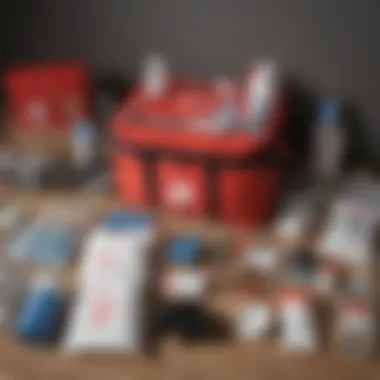Home Emergency Kit: Essential Checklist and Tips


Intro
A well-prepared home is essential for managing unforeseen events. Emergencies can range from natural disasters like hurricanes and earthquakes to man-made incidents. In such situations, having a well-assembled emergency kit can provide critical support. An organized kit empowers families to handle difficulties with greater confidence. This guide aims to present a detailed checklist for assembling an effective home emergency kit. It will highlight key items, their importance, and provide practical organization tips.
Coverage Options
When discussing home emergency preparedness, it is important to consider the coverage options available for countless perils. Different scenarios require different considerations, hence understanding their nature becomes fundamental.
Types of Coverage Available
There are several categories of coverage one might explore, which can aid in securing peace of mind:
- Home Insurance: This can protect the structure and contents of the home against damages.
- Natural Disaster Coverage: Specific policies can cover damages due to events like floods, earthquakes, or tornadoes.
- Liability Protection: This coverage helps protect against claims of property damage or injury from someone visiting your home.
Understanding these options not only safeguards your assets but also supports you in your emergency planning efforts. Knowing what is covered can tailor your emergency kit to include relevant items applicable for potential risks in your area.
Liability Coverage Explained
Liability insurance is particularly relevant for homeowners. It provides financial support in case of accidents that occur on your property. This means that if a guest is injured or their property gets damaged, your liability coverage can help mitigate costs. This alleviates some anxiety associated with having visitors during emergencies.
Key Considerations
In choosing the right insurance options and assembling an emergency kit, there are several key considerations to take into account:
Factors to Assess When Choosing Insurance
When selecting insurance, consider the following:
- Location: Certain regions are more prone to specific disasters. Assess local risks.
- Coverage Limits: Each policy has limits on payouts. Ensure adequate coverage.
- Deductibles: Understand the amount you must pay out-of-pocket before insurance kicks in.
Understanding Policy Limits
Insurance policy limits define the maximum amount a company will pay for a covered loss. It is vital to be aware of these limits and make sure they align with your needs. If your home is worth a significant amount or contains valuable items, ensure your coverage reflects this.
Keeping your policies updated helps address evolving risks and changes in asset value. Regularly review policies to stay informed.
Understanding the Importance of an Emergency Kit
An emergency kit serves a critical role in preparing for unforeseen events. The significance of assembling a well-thought-out emergency kit cannot be overstated. Emergencies can strike at any moment, and having the right supplies on hand ensures safety and supports quick response. The primary goal of an emergency kit is to provide basic needs and resources during a crisis, whether caused by natural disasters or unexpected incidents.
Reasons for Preparation
Preparing for emergencies involves anticipating potential threats that can impact you. Having an emergency kit directly supports readiness. Major reasons for building an emergency kit include:
- Safety: Ensuring you have essential resources can save lives. Supplies like food, water, and first aid materials are crucial.
- Self-sufficiency: In emergencies, help may not arrive quickly. A well-stocked kit enables self-reliance until support is available.
- Peace of mind: Knowing you are prepared reduces anxiety during crises. Preparedness allows you to face uncertainty with better confidence.
Common Emergency Scenarios
Understanding specific emergency scenarios that may arise enhances the relevance of an emergency kit. Common situations include:
- Natural disasters, such as hurricanes, earthquakes, and floods. These events often disrupt utilities, making basic supplies critical.
- Fires can lead to sudden evacuations, necessitating grab-and-go essentials.
- Public health emergencies, like pandemics, underline the importance of hygiene and medical supplies.
- Sudden job loss or financial crises highlight the need for non-perishable food and basic necessities.
Being aware of these scenarios helps in tailoring the contents of your emergency kit effectively.
Psychological Benefits of Preparedness
Beyond physical readiness, psychological aspects also play a significant role. Preparedness can result in notable mental well-being benefits:
- Reduces Stress: Knowing you are prepared alleviates the overwhelming fear associated with uncertainty and disasters.
- Boosts Confidence: Proactively managing emergencies through preparation fosters a sense of control.
- Encourages Proactive Behavior: Engaging in preparedness activities motivates individuals to think ahead, impacting other life aspects positively.
"A prepared mind leads to quicker decision-making when faced with unexpected challenges."
In summary, understanding the importance of an emergency kit is vital for homeowners and business owners alike. It not only serves as a lifeline in crises but also builds confidence through systematic preparation.


Essential Items for an Emergency Kit
Creating an emergency kit is not just a task; it is an essential strategy for ensuring safety and preparedness in uncertain situations. This section elaborates on the crucial components that every emergency kit should include. Each item listed serves a specific purpose and can be a lifeline in dire conditions. Understanding these essential items is pivotal for homeowners, vehicle owners, and business occupants, as they prepare for potential emergencies.
Water Supply
Water is the most fundamental need during emergencies. In a crisis, clean drinking water may not be readily available due to service disruptions. It’s advisable to include at least one gallon of water per person per day, enough for at least three days.
- Storage considerations: Use BPA-free containers. Make sure they are opaque to avoid light degradation.
- Alternative sources: Keep water purification tablets in your kit. This can be lifesaving if water sources get compromised.
Non-Perishable Food
Non-perishable food is essential because it provides the necessary calories and nutrients when cooking facilities might be unavailable. Suitable options include canned goods, dehydrated meals, or ready-to-eat meals.
- Stocking tips: Choose high-energy foods. Include items like protein bars, nuts, and peanut butter. They are easy to store and don’t require cooking.
- Rotating your stock: Regular checks for expiration dates will ensure food safety and freshness.
First Aid Supplies
In emergency situations, injuries can occur. Having a well-stocked first aid kit can manage minor injuries and stabilize conditions while waiting for professional medical help.
- Must-have items: Include bandages, antiseptic wipes, pain relievers, and scissors. Each component will facilitate basic medical assistance.
- Training: Familiarize yourself and your family with first-aid practices. This knowledge is as vital as the supplies themselves.
Tools and Equipment
Tools aid in managing emergency situations effectively. Include essential items that can help with repairs or aid in accessing resources.
- Suggested tools: A multipurpose tool, flashlight with extra batteries, and a whistle. Each can serve multiple functions in various situations.
- Safety gear: Consider safety gloves and masks, especially in scenarios where debris removal is necessary.
Communication Devices
During emergencies, staying informed and connected is crucial. Communication devices help you obtain updates and coordinate rescue efforts if required.
- Cell phones: Keep a portable charger or solar-powered device. This ensures your phone remains operational even during power outages.
- Emergency radios: Hand-crank or battery-operated radios can keep you informed about local emergencies and updates.
Personal Hygiene Items
Maintaining hygiene is important for both comfort and health. Incorporate hygiene products into the emergency kit to prevent illness.
- Essential items: Include items such as soap, hand sanitizer, toothbrushes, and sanitary products. These contribute to well-being during stressful times.
- Waste disposal: Pack garbage bags for hygienic waste disposal. This is often overlooked but is critical in disaster situations.
Clothing and Blankets
In emergencies, appropriate clothing and bedding can provide warmth and comfort. Weather conditions can be unpredictable, hence it's vital to prepare accordingly.
- Basic clothing: Include a change of clothes and sturdy shoes for each family member. Layering is key, as temperatures can fluctuate.
- Blankets: Add thermal blankets or sleeping bags. These are space-efficient and offer excellent warmth in cold conditions.
Important Documents
Document preparedness is often neglected but plays a significant role during emergencies. Keeping copies of essential documents ensures vital information is available when needed.
- What to include: Identification, medical records, and property deeds. Store them in a waterproof bag.
- Digital backups: Consider scanning important papers and saving them in a secure cloud service. This adds an extra layer of safety.
Having an emergency kit tailored to your unique needs is invaluable in a crisis. Each component is a building block for resilience.
This section has aimed to provide you with the key items needed in your emergency kit. The choices you make about what to include will ultimately enhance your safety during unexpected situations. Creating a comprehensive emergency kit is not just a precaution; it is a sound investment in your and your family's well-being.
Customizing Your Emergency Kit
Customizing your emergency kit is a critical step in ensuring it meets the specific needs of your household. A standardized kit may provide a foundation, but personalizing it can greatly enhance its effectiveness during an actual emergency. It is important to consider various factors such as family composition, pet ownership, and regional climate when tailoring your emergency kit. Doing so not only ensures that you are prepared for the unexpected but also boosts confidence among household members during stressful situations.
Family Needs and Situations
When creating an emergency kit, start by assessing your family's unique requirements. Each household is different. For example, families with young children will need to include items like diapers, baby formula, and age-appropriate activities to keep them occupied. If you have elderly family members, consider adding medical supplies or daily medications they may need. This thoughtful approach does not only address immediate survival needs but also takes into account the psychological comfort of family members during a crisis.
Moreover, be aware of individuals with special needs in your household and incorporate necessary support items. Some families may also have specific dietary restrictions, requiring alternative food options. Addressing these specific needs can ensure that, even in the face of calamity, all family members are taken care of appropriately.


Pet Considerations
Pets are part of the family and should not be overlooked in your emergency preparations. Just as you customize your emergency kit for family members, consider what your pets will require. This includes provisions for food, water, and medications. Install a small pet bag in your emergency kit containing these essentials, along with a leash and pet first-aid supplies.
Additionally, think about their comfort. Familiar toys or bedding can help keep them calm during stress. If you have multiple pets, tailor their needs together to ensure that each one has sufficient resources available. Pets might react differently during emergencies, so a prepared kit can aid in managing their anxiety as well as your own.
Seasonal Adjustments
Another vital aspect of customizing your emergency kit is considering seasonal changes. Your environment plays a role in defining what should be included. For instance, if you live in a region prone to winter storms, adding blankets, shovels, or ice scrapers to your kit is sensible. In warmer locales, focus on heat-related supplies, such as sunscreen and electrolyte drinks.
Review your kit at changing seasons to refresh supplies or add necessary items. This ensures the effectiveness of your emergency kit throughout the year. Regularly updating it not only keeps it relevant but also allows you to incorporate any new advice or resources you may have come across since your last review.
Keeping your emergency kit tailored and relevant can significantly impact your readiness during emergencies and help alleviate stress on all fronts.
Organizational Strategies for Your Kit
Establishing effective organizational strategies for your home emergency kit is crucial for maximizing efficiency and accessibility during crises. A structured approach can ensure that you and your family can locate necessary items quickly, reducing panic and confusion. The way the kit is set up can enhance preparedness and make the entire experience less stressful. It also allows you to regularly manage the contents, ensuring that your supplies remain reliable and ready for use.
Selecting the Right Container
The choice of container can greatly influence how well your emergency kit is organized. A suitable container should be durable, waterproof, and easily transportable. Consider options such as plastic bins, backpacks, or duffel bags. Each of these choices offers distinct advantages:
- Plastic Bins: They provide sturdy protection against moisture and damage. It is also beneficial to use bins that stack easily to save space.
- Backpacks: These allow for easy carrying if evacuation becomes necessary. Look for options with multiple compartments to separate different types of supplies.
- Duffel Bags: They can hold larger items efficiently and can also be carried over the shoulder for easy transport.
Ensure the container is clearly labeled. This will help anyone in your household know where to find the contents in an emergency.
Efficient Item Placement
Once you have selected the container, efficient item placement will play a vital role in your kit’s overall effectiveness. Items should be arranged in a way that prioritizes accessibility and logic. For example:
- Frequently Used Items: Place these at the top or in an easily reachable area. Think about things like first aid supplies, flashlights, and batteries.
- Grouped Categories: Organize items into specific categories, such as food, water, medical supplies, and tools. Use small containers or zip-lock bags within the larger kit to keep similar items together.
- Visibility and Clarity: Consider using clear bags or containers to make it simple to see the contents at a glance. This can prevent unnecessary rummaging during high-pressure situations.
Such methods ensure that no time is wasted in retrieving essential supplies.
Regular Inventory Checks
To maintain the integrity of your emergency kit, conducting regular inventory checks is essential. Create a schedule, ideally every six months or following any significant emergency event. During these checks:
- Assess Expiration Dates: Many items, especially food and medical supplies, come with expiration dates. Make sure to replace anything that has expired.
- Evaluate Inventory Levels: If you have used items from your kit, make a note to replenish those supplies immediately. Running low on water or first aid supplies can be dangerous.
- Revisit Needs: As your family's circumstances change, so may your emergency needs. For instance, if you have a baby now, you might need to add formula or diapers.
These checks will ensure your emergency kit stays up to date and ready for use at any moment. Remember, the goal is to simplify access during an already stressful time.
Educating Household Members
Educating household members about emergency preparedness is critical. This foundation can make a significant difference during actual emergencies. Knowledge empowers individuals to respond effectively, reducing chaos and confusion in stressful situations.
Training for Emergencies
Training household members for various emergency scenarios is essential. This training should include basic first aid and CPR techniques. Familiarizing everyone with the emergency kit's contents can cut down response time. It is also useful to practice evacuation routes and strategies.
Organized drills help reinforce these plans. Family members, including children, should understand how to react. Regularly scheduled practice ensures that each person knows their role, making the family unit more effective during crises. In addition to practical training, consider discussing specific local hazards, such as earthquakes or floods. By doing this, individuals can better grasp the urgency and importance of the preparation.
Establishing Communication Plans
Establishing a clear communication plan is vital. In emergencies, individuals may lose their phones or face network outages. A written plan, distributed among family members is a good solution. Each person should have a hard copy of emergency contacts, including local emergency services.
Moreover, settings must also include a designated meeting place. This strategy can aid family members in reuniting if separated.
Regular check-ins can ensure everyone knows the current plan. Use family gatherings to review this strategy openly. This habit keeps it fresh in everyone's mind, reinforcing its importance. By involving each member, the group becomes a cohesive unit prepared for emergencies.
Staying Informed During Emergencies
Staying informed during emergencies is a critical component of any effective emergency preparedness strategy. Access to reliable information can mean the difference between safety and exposure to danger. Without accurate updates about the situation, it is easy to make poor decisions that could jeopardize personal safety or that of loved ones.


Knowing where to obtain information in real-time enhances the ability to respond effectively. In stressful or chaotic situations, clarity is essential. Relying on diverse sources of reliable information is beneficial because it helps verify facts and avoid panic-driven decisions. This section will discuss the different types of reliable information sources available and the roles of local emergency services.
Reliable Sources of Information
Accessing credible information during emergencies can significantly impact decision-making processes. Here are some key sources to consider:
- Government Websites: Official government websites often provide the most up-to-date information regarding disasters, safety protocols, and evacuation routes. Websites such as FEMA (Federal Emergency Management Agency) are valuable resources.
- News Outlets: Reputable news organizations can offer real-time updates on situations impacting communities. It is essential to choose well-established outlets that prioritize accuracy.
- Social Media: While social media platforms can spread information quickly, caution is necessary. Verify information through fact-checkers before acting on something seen online.
- Weather Services: Meteorological sources provide critical updates during natural disasters. Monitoring local weather services can help anticipate threats and plan accordingly.
Local Emergency Services
Understanding the role of local emergency services can enhance preparedness further. These services-coordinate disaster response and implement safety measures.
- Fire Departments: Fire services respond to fires, natural disasters, and emergencies requiring evacuation. They often engage in community education regarding preparedness.
- Police Departments: Local law enforcement maintains public safety during emergencies. They can provide information about curfews, evacuation routes, and risks in specific areas.
- Emergency Medical Services (EMS): EMS offers critical medical assistance during crises. Knowing how to reach local EMS can be essential in serious situations.
- Community Organizations: Local nonprofits may offer resources during emergencies. They can disseminate vital information and provide support.
In summary, combining various information sources can help homeowners stay informed during emergencies, making it easier to navigate challenges effectively.
It is advisable to familiarize oneself with these sources before an emergency occurs. By having a plan in place, individuals can ensure a more organized response when faced with unexpected situations.
Updating Your Emergency Kit
Keeping an emergency kit current is essential for any homeowner. Situations can change rapidly. Over time, new needs may develop or the contents may degrade. Regular updates ensure that your kit remains effective and relevant to your specific circumstances. Failing to update your kit can result in having outdated supplies that may not serve you in a crisis, ultimately endangering your safety and preparedness.
Expiration Dates and Replacements
Many items in an emergency kit have a limited shelf life. For instance, batteries, medications, and food items can expire. It is vital to check the expiration dates periodically. This is often overlooked but can have significant consequences in an emergency. For example, using expired medication during a crisis could delay recovery or make conditions worse.
- Batteries: Replace them every year, even if they are still in good condition. They can lose charge over time, regardless of shelf life.
- Food Supplies: Non-perishable items should be rotated and replaced as necessary. Canned goods may last a long time, but it is good practice to use those close to expiration for everyday consumption.
- First Aid Items: Always ensure that antiseptic wipes, ointments, and medications like pain relievers are not expired.
Utilizing a checklist can simplify this process. Set reminders to review your kit every six to twelve months. This way, you can catch any issues before an emergency occurs.
Incorporating New Needs
As your life changes, so should your emergency kit. Changes in family size, health conditions, or other lifestyle alterations need to be reflected in the kit. Here are some considerations:
- Growing Families: If a new baby arrives, include infant supplies such as diapers, formula, and other essentials.
- Medical Considerations: If someone in your household develops a medical condition, make sure to include special medications and equipment. This could range from insulin and needles to specialized bandages.
- Allergies: Consider adding epinephrine auto-injectors for severe allergies if someone in your family is at risk.
- Pets: If you have pets, don't forget their needs. Pack pet food, water, and medications relevant to their care.
"Updating your kit is not just about replacements. It is about ensuring preparedness for every evolving situation."
By reflecting on these aspects when updating your kit, you keep it relevant and effective. Adaptability is key to maintaining preparedness in the face of unexpected events.
Resources for Further Guidance
In times of crisis, having access to reliable, structured support can significantly improve your preparedness and response. Resources for further guidance serve as crucial assets, enhancing the effectiveness of your home emergency kit. Utilizing these resources not only helps individuals stay informed but also fosters community resilience. When you know where to find accurate information or assistance, you can respond more confidently to emergencies.
In this section, we will explore both government recommendations and community preparedness programs. Each of these components plays a vital role in providing the public with essential guidance and support during crises. Understanding how to access and utilize these resources effectively can make a substantial difference in your emergency readiness.
Government Recommendations
Government agencies play a pivotal role in shaping public emergency preparedness practices. These recommendations are often based on extensive research and expert opinions. They provide detailed advice on how to prepare for various types of emergencies, such as natural disasters, public health crises, and other unexpected events.
For instance, the Federal Emergency Management Agency (FEMA) offers guidelines on assembling emergency kits, developing family communication plans, and staying informed during disasters. Their instructions are clear and cater to diverse scenarios.
Here are a few key points about government recommendations:
- Official Guidelines: They outline what to include in your emergency kit and how to prepare your household.
- Tailored Advice: Recommendations are often specific to local risks, considering factors like geography and climate.
- Regular Updates: Government sites frequently revise their information to keep up with new research.
You can find valuable information on resources such as FEMA and the CDC.
"Preparedness is not just about survival; it's about informed decisions that can save lives."
Community Preparedness Programs
Community preparedness programs are another essential element that supports individuals and families in emergency situations. These programs foster cooperation among community members and local organizations. They aim to equip residents with the knowledge and tools they need to respond effectively during emergencies.
Participating in community preparedness programs has various advantages:
- Local Support: These programs often provide direct connections to local emergency services and resources.
- Training Opportunities: Many communities offer workshops on first aid, disaster response, and effective communication plans.
- Shared Knowledge: Engaging with neighbors allows for the exchange of ideas about improving everyone's emergency readiness.
Local agencies or organizations, such as the Red Cross, often conduct these programs. You should check on what is available in your area to ensure you are not missing out on valuable resources.
Utilizing the resources outlined in this section will undoubtedly enhance your understanding and capability to handle emergencies more effectively.



